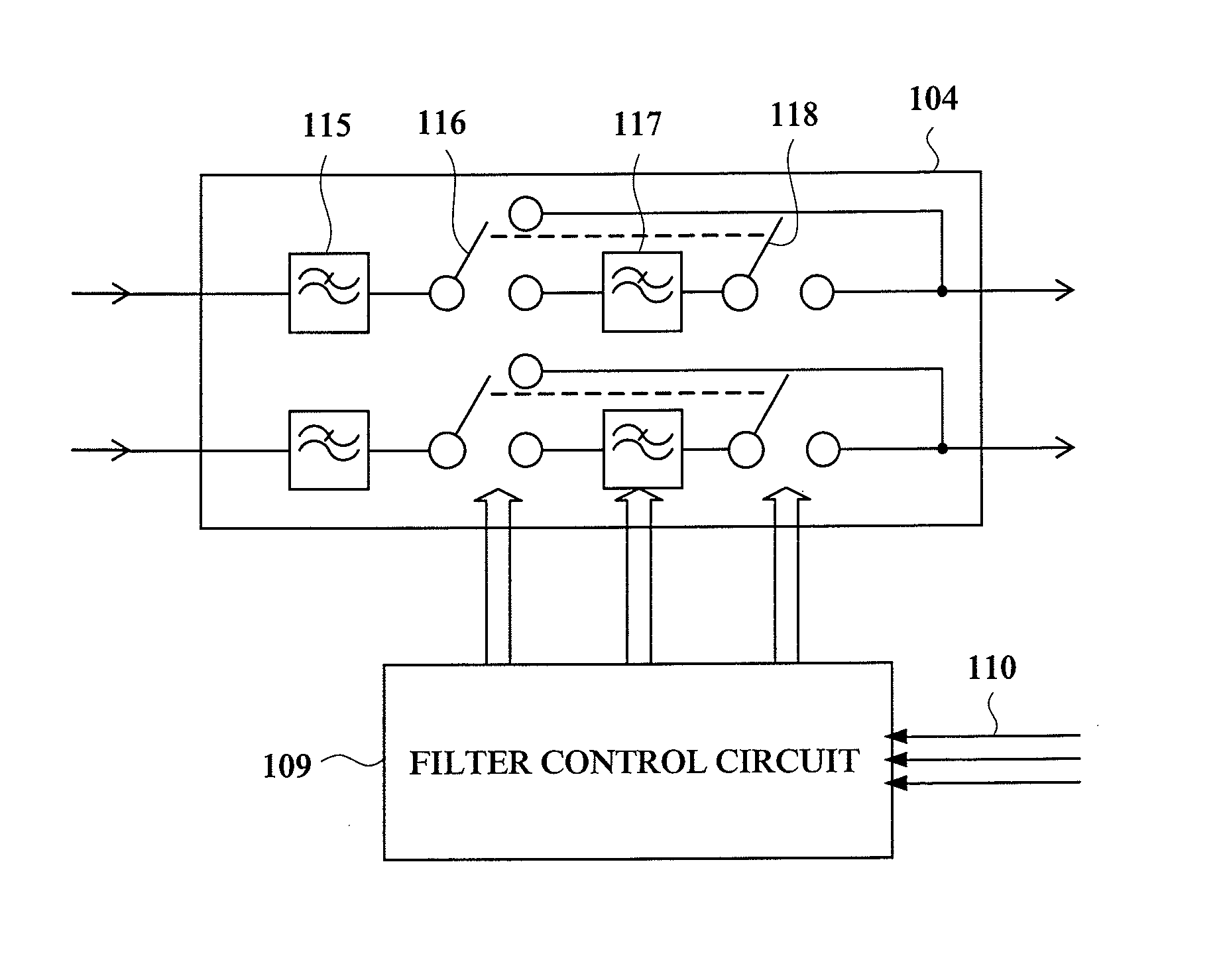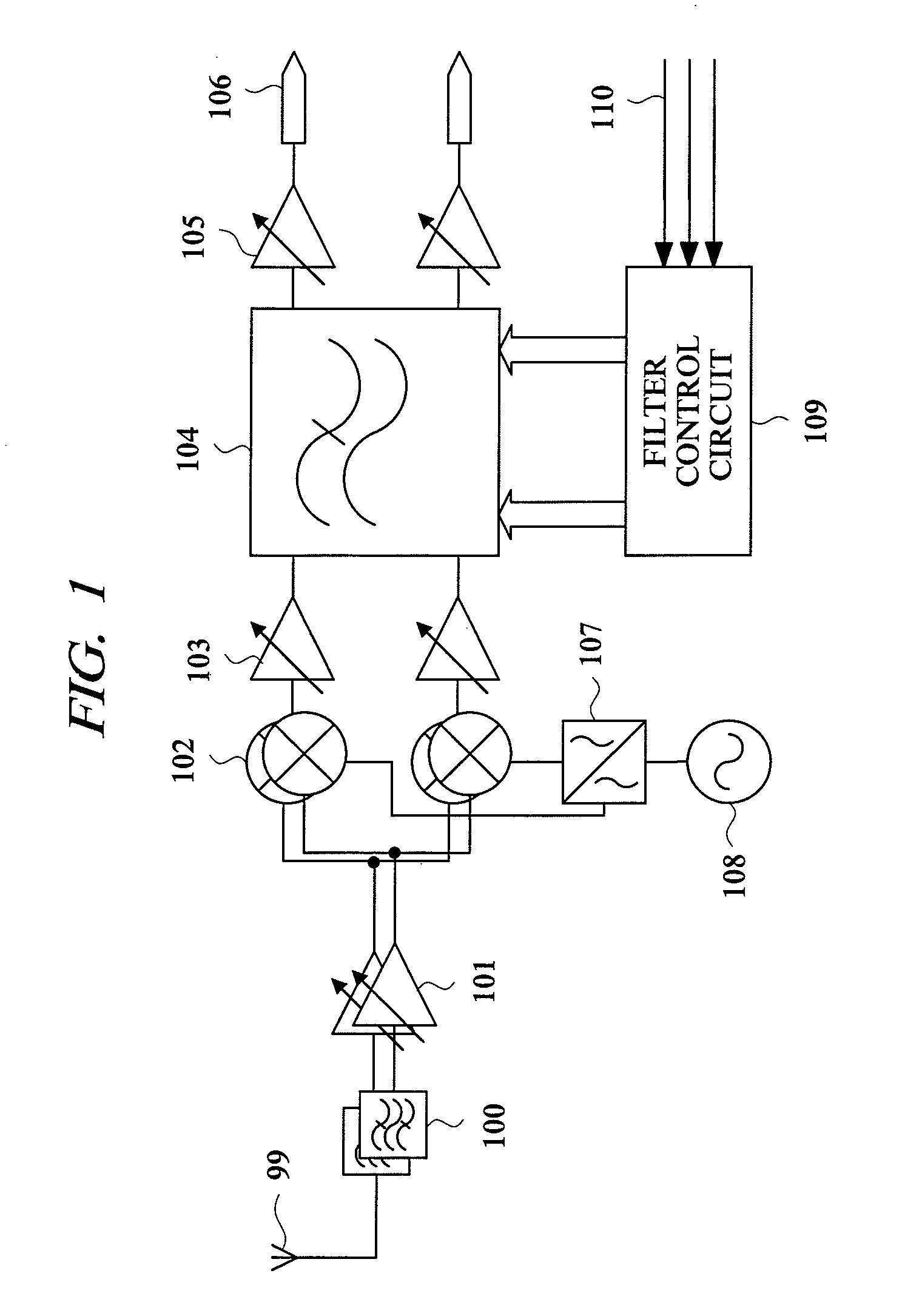Receiving circuit
a technology of receiving circuit and reference sensitivity, which is applied in the field of receiving circuit, can solve the problems of increasing current consumption and becoming difficult to achieve the reference sensitivity of 117 dbm, and achieve the effect of reducing size and low power consumption
- Summary
- Abstract
- Description
- Claims
- Application Information
AI Technical Summary
Benefits of technology
Problems solved by technology
Method used
Image
Examples
first embodiment
[0034]First, referring to FIG. 1, one example of a configuration and an operation of a receiving circuit in a first embodiment of the present invention will be explained. FIG. 1 shows a configuration of the receiving circuit in the first embodiment.
[0035]In FIG. 1, the receiving circuit in the embodiment is used in a cellular phone performing transmission and reception of a plurality of band wireless signals, and it is composed of an antenna input terminal 99, a band-pass filter 100, an LNA 101, a mixer 102, a first amplifier circuit 103, a low-pass filter 104, a second amplifier circuit 105, an output terminal 106, a 90-degree phase-shifting circuit 107, a local oscillator 108, a filter control circuit 109, and the like, and a band selection signal 110 is inputted into the filter control circuit 109.
[0036]The receiving circuit is composed of mixers 102, first amplifier circuits 103, low-pass filters 104, second amplifier circuits 105, and output terminals 106, which are paired, res...
second embodiment
[0060]Referring to FIG. 9, one example of configuration and operation of a low-pass filter in a receiving circuit of a second embodiment of the present invention will be explained. FIG. 9 shows the configuration of the low-pass filter.
[0061]Since the receiving circuit in this embodiment is similar to that shown in FIG. 1 showing the first embodiment, detailed explanation thereof is omitted. Here, a tangible configuration example of a low-pass filter in a receiving circuit that can receive bands I and III of UMTS is shown.
[0062]In FIG. 9, a low-pass filter 104 in the embodiment is composed of a first switch 125, a first filter 126, a second filter 127, a second switch 128, and the like, and its different point from the first embodiment is that the first filter 126 and the second filter 127 are connected in parallel.
[0063]The first filter 126 is a filter used at a reception of band I and the second filter 127 is a filter used at a reception of band III. The first filter 126 is a filte...
third embodiment
[0069]Referring to FIG. 10, one example of configuration and operation of a low-pass filter in a receiving circuit of third embodiment of the present invention will be explained. FIG. 10 shows the configuration of the low-pass filter.
[0070]Since the receiving circuit in this embodiment is similar to that shown in FIG. 1 showing the first embodiment, detailed explanation thereof is omitted.
[0071]In the receiving circuits having the configurations of the first and second embodiments, in reception of bands I, II, and III signals of UMTS, there is a difference such that in reception of band II signal, an offset frequency of a blocker signal is 2.7 MHz, while in reception of band III signal, an offset frequency of a blocker signal is 2.8 MHz, so, by adopting a configuration that the notch frequency of the second filter constituting the low-pass filter 104 receiving band II and band III signals can be switched to the frequency of the blocker signal, a filter with a higher reference sensit...
PUM
 Login to View More
Login to View More Abstract
Description
Claims
Application Information
 Login to View More
Login to View More - R&D
- Intellectual Property
- Life Sciences
- Materials
- Tech Scout
- Unparalleled Data Quality
- Higher Quality Content
- 60% Fewer Hallucinations
Browse by: Latest US Patents, China's latest patents, Technical Efficacy Thesaurus, Application Domain, Technology Topic, Popular Technical Reports.
© 2025 PatSnap. All rights reserved.Legal|Privacy policy|Modern Slavery Act Transparency Statement|Sitemap|About US| Contact US: help@patsnap.com



